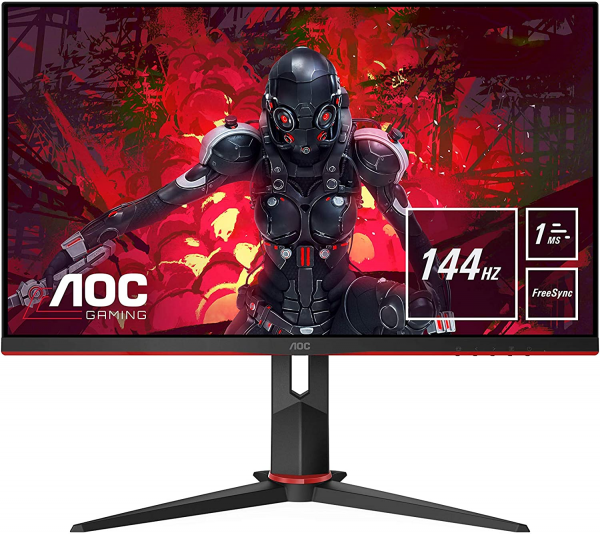AOC
27 inch AOC 27G2U monitor: the best value for money Full HD 144 Hz for gamers?
Aprox. 249€
See specificationsDisplayed at € 250, the AOC 27G2U at first glance seems to be the perfect screen for players with its Full HD 144 Hz IPS panel, FreeSync compatibility, ergonomics and comprehensive connectivity. What about in practice?
Positive points
Image quality.
Good contrast for an IPS panel.
Reactivity.
Native frequency of 144 Hz.
FreeSync / G-Sync compatibility.
Complete ergonomics (height and rotation adjustment).
Connections provided.
Bad points
Absence of black image insertion system (ELMB or ULMB).
Our review
Presentation
This monitor is built around a 27-inch IPS panel displaying a Full HD definition of 1,920 x 1,080 pixels and supporting a native refresh rate of 144 Hz. It is part of this new generation of monitors incorporating an announced IPS panel with a response time of 1 ms (compared to 5 ms usually for monitors using this type of LCD technology). It doesn't stop there since it also supports a native frequency of 144 Hz as well as FreeSync, and by extension G-Sync. Its well thought out ergonomics provides an adjustable foot in all directions and a rather exhaustive connection with USB 3.0 hub.
Sold around 250 €, the AOC 27G2U does not really have a direct competitor on the market. The Asus TUF VG27AQ with its 144 Hz IPS panel displaying a Quad HD definition (2,560 x 1,440 pixels) is sold for double.
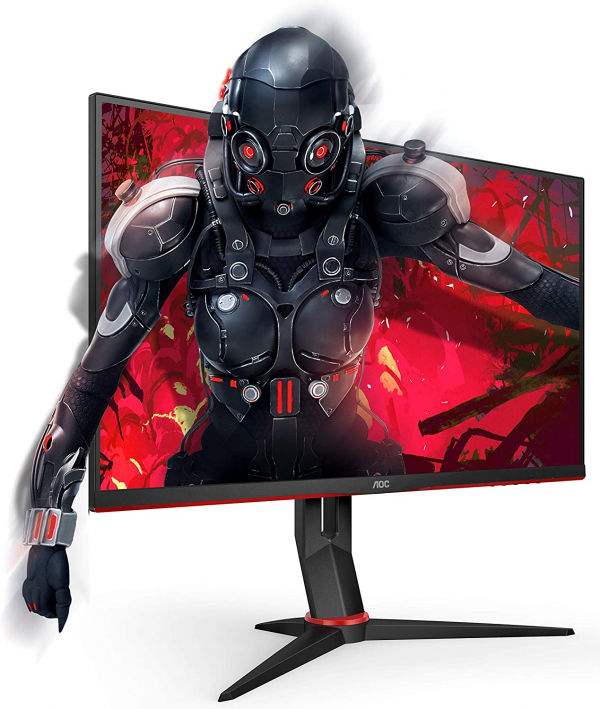
Ergonomics
The AOC 27G2U is rather sober for a gaming monitor. The small touches of red at the base of the slab and the foot leave no doubt about the target of this screen.
The ergonomics are excellent: height adjustment on 13 cm and tilt between -3.5 ° and + 21.5 °. The foot also allows rotation through ± 30 °. But this last adjustment lacks fluidity and the stand tends to come with the screen.
The rear of the chassis is made entirely of grainy mat black plastic. The red inserts again reminds the gaming side of the monitor, but without excess. The connection is oriented downwards. The base of the foot has a fairly narrow cable passage which does not allow all cables to pass, but it is enough for the DisplayPort, an HDMI and a few USB cables. The screen is compatible with VESA 100 x 100 mm fixings, but for this you have to dismount the stand.
The connectivity is rather exhaustive since there are two HDMI inputs, a DisplayPort input, a VGA input, an audio input and output 3.5 mm mini-jack and four USB 3.0 ports. It also has two 2 W speakers, far from exceptional, but which even troubleshoot system sounds and short videos.
The four buttons used to control the OSD are probably among the worst on the market. They are very hard and the click feedback is sometimes imperceptible and therefore subject to numerous handling errors. We are very far from the practicality offered by the clickable joystick now used by many manufacturers. The slightly dated design of the menus does not help matters and, finally, some settings simply do not work (the overdrive for example). On this point, it is clearly not a success, but fortunately, this monitor has other arguments to make.
On our 140 x 60 cm desk, the AOC 27G2U is comfortable with its 27 inch diagonal. The depth of the foot limited to 22.7 cm associated with its light shape allows to leave enough space for the keyboard and the mouse. The Full HD definition of 1,920 x 1,080 px is perfect for games, especially at 144 Hz, but it is limited for other tasks and you can quickly run out of work space.
By lowering the brightness to 39 to obtain a white at 150 cd / m², the consumption of the AOC 27G2U is limited to 14 W, ie a relative consumption of only 70 W / m², much lower than the average consumption of the monitors tested ( 100 W / m²). At the minimum of brightness (39 cd / m²), it consumes only 8 W. At the maximum (308 cd / m²), consumption rises to 24 W.
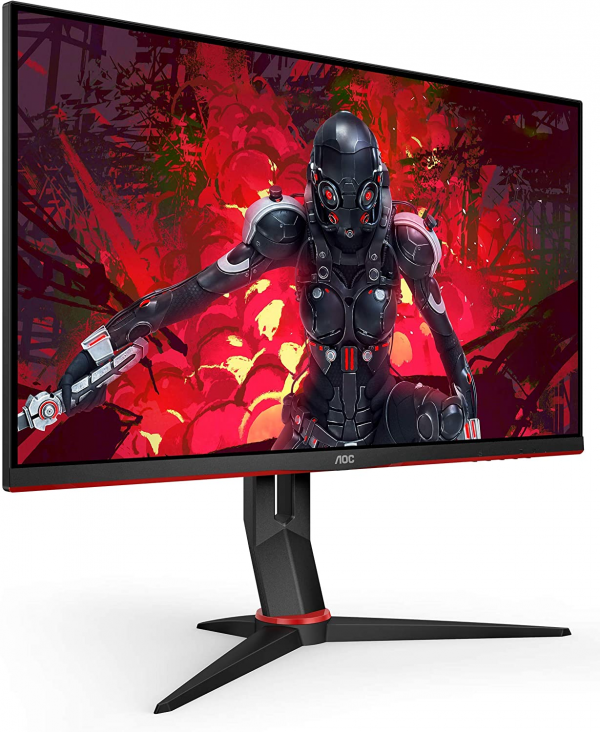
Colors and contrast
The AOC 27G2U is fairly well calibrated when it comes out of the box. The temperature curve is perfectly stable over the entire spectrum and the average measured at 6,880 K is fairly close to the video reference value of 6,500 K. With an average delta E of 2.4, the colors can be considered as true to those sent by the source , especially since only the blue very slightly exceeds a delta E of 3. There is only the gamma curve which slightly lacks stability, with an average measured at 2, which is quite far from the reference value (2.2).
We lowered the brightness to 39 to obtain a white close to 150 cd / m². The monitor does offer three levels of gamma, but the upper level has a gamma of 2.4 and the lower level has a gamma of 1.8. The results are thus very close to those of the default mode. The opportunity to see that the variation of the backlight has no impact on the rendering.
The calibration of the screen using a probe above all makes it possible to smooth the gamma curve which is now perfectly stable at a value of 2.2. The color rendering is further improved (average delta E at 1.7) and blue sees its delta E passing just below 3. You can download this color profile by following this link.
The panel of this AOC monitor displays a very good native contrast of 1250: 1 for an IPS monitor. It immediately rose among the best representatives of this LCD technology. Despite everything, the AOC 27G2U remains far from the best VA monitors on the market, like the Philips Momentum 436M6 or the MSI Optix MAG271CR whose contrast ratio exceeds 4,000: 1. The darkest scenes and the solid black areas always appear greyish, especially in a dark room, but this is not a problem during daytime use.
The average difference in white homogeneity is 7% on the 27-inch panel. There is thus no variation in the brightness perceptible to the eye. We did not find any light leaks in the corners or any clouding ("cloud effect") on our test model. IPS technology also offers very good viewing angles with very little variation in angles.
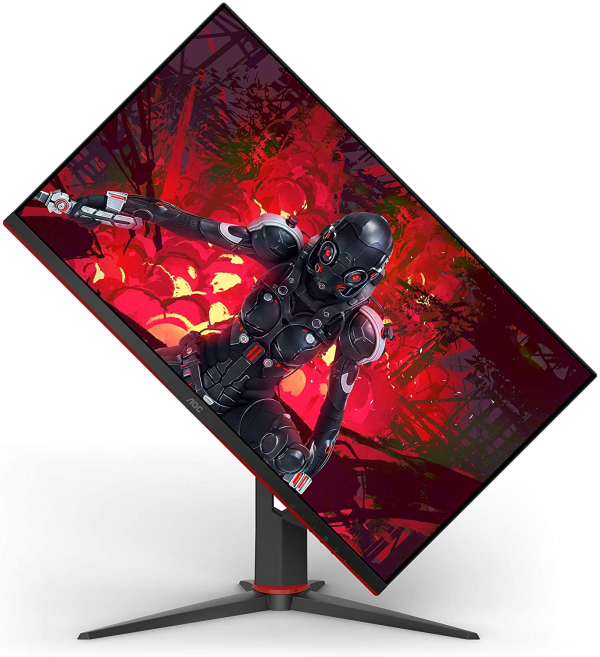
Reactivity
The AOC 27G2U does not use Pulse Width Modulation (PWM) to adjust the brightness; it is therefore devoid of flicker and does not cause headaches for those who are sensitive to this phenomenon. The monitor also has a mode to reduce blue light emission in software - this changes the color temperature to make it warmer.
This monitor manages FreeSync and G-Sync between 48 and 144 Hz and therefore works optimally when the graphics card sends between 48 and 144 images per second. Between 20 and 47 Hz, the monitor uses the LFC system for Low Frame Compensation which quadruples, triples or doubles the number of images displayed in order to maintain a feeling of fluidity. At 20 frames per second, for example, the monitor operates at 80 Hz and quadruples the number of images. At 30 frames, it operates at 90 Hz. It uses the CFL only between 53 and 144 Hz. The range supported is therefore very wide and covers all uses. The Full HD definition makes it possible to opt for a mid-range graphics card like the GeForce RTX 2060 Super or the Radeon RX 5700 XT while enjoying a sufficiently high refresh rate. In all cases, the fluidity is there and the image does not suffer from tearing problems or jerks (micro-stuttering).
The monitor does not offer a black image insertion system to improve the sharpness of moving objects by deceiving retinal persistence.
We measured the remanence time at 7.5 ms. The AOC 27G2U therefore does better than the Asus TUF VG27AQ, the previous record holder in the category of IPS monitors. It is simply the best afterglow time measured on an IPS panel. It still does not equal that of the best TN screens like the Alienware AW2518HF 240 Hz flashed at 3 ms, but the IPS panel has many more qualities (viewing angles, contrast). The modification of the overdrive did not work on our test monitor (the modification of the value had no impact on ghosting) and, by default, the ghosting is very light; the setting is therefore satisfactory. Finally, we measured the delay in the display (input lag) at 9.3 ms (at 60 Hz). There is therefore no lag between the action with the mouse and its repercussion on the screen.
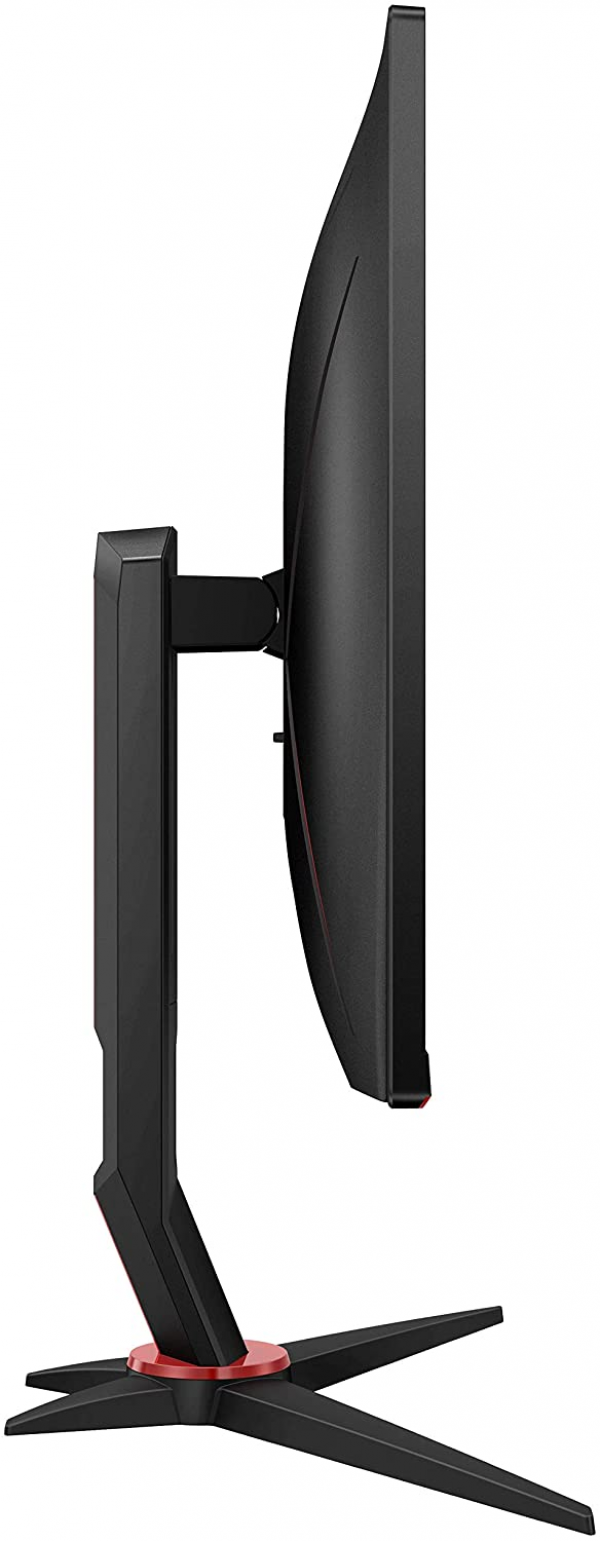
Conclusion
The AOC 27G2U is undoubtedly one of the best gaming monitors currently available on the market. It benefits from an excellent quality / price ratio and has nothing to envy to more upscale monitors. It offers complete ergonomics, exhaustive connectivity and an image quality far above average, in addition to that excellent responsiveness and FreeSync / G-Sync compatibility which ensures perfect fluidity. This is for us the best Full HD monitor for gamers. Those who want a higher definition will turn to the Asus TUF VG27AQ, twice as expensive ...
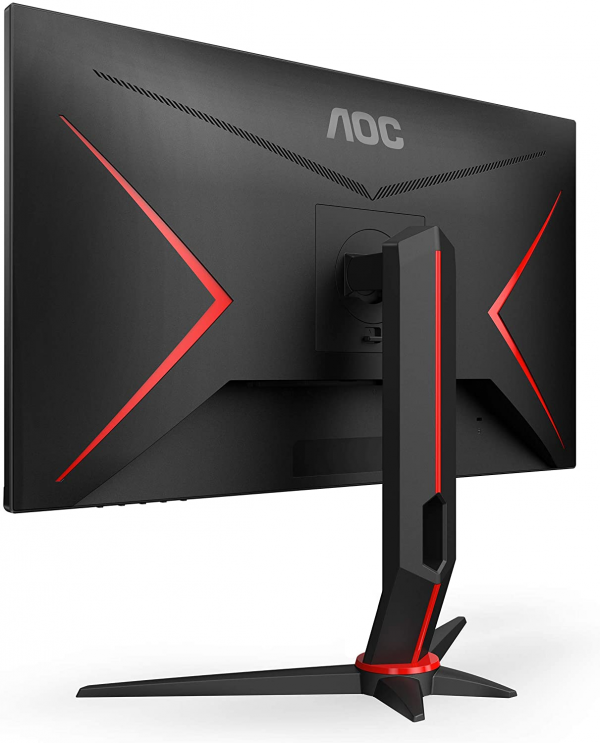
Specifications

